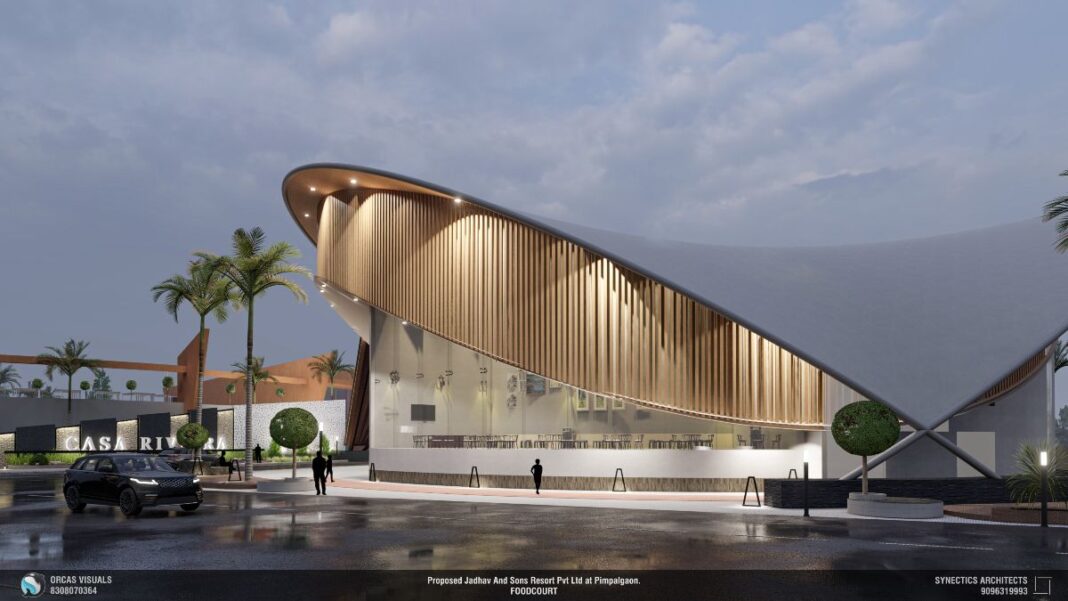The Casa Riviera in Pimpalgaon, Maharashtra, reflects the architect’s vision of creating a vibrant, multifunctional space that fosters community interaction and user engagement. The design integrates modern architectural trends, blending functionality with aesthetics. Facilities are strategically placed to enhance connectivity, offering a cohesive experience where leisure, dining, and social interaction converge. The food court’s thoughtful layout incorporates shaded outdoor seating, promoting a seamless connection with the surrounding environment.
Incorporating cutting-edge energy solutions, the campus prioritises sustainability and future-proofing. Integrated solar panels, energy-efficient systems, and advanced materials like high-performance glazing and thermal-insulated cladding reduce operational costs and environmental impact. Smart building technologies, such as automated lighting and climate control, optimise energy usage, ensuring the campus is both comfortable and environmentally responsible.
Dhananjay Pawar, Principal Architect, Synectics Architects, highlights the design’s flowing curves, bold geometry, natural materials, open spaces, and dynamic lighting embody innovation, sustainability, and harmony with the environment.
Curvilinear Craft
The design of Casa Riviera envisions a vibrant, multifunctional space that fosters community interaction, blending modern aesthetics with functionality to create a cohesive, engaging experience. Innovative elements like curvilinear forms and horizontal and vertical louvres break away from rigid structures, creating a sense of fluidity and dynamism. These elements optimise spatial planning, ensuring seamless movement while enhancing both aesthetic appeal and energy efficiency. The louvres regulate natural light, reduce glare, and add texture to the facade. In contrast, the interplay of light and shadow highlights the building’s modern character, establishing the campus as a visually striking and environmentally responsive space.
Steel was chosen as the primary material for its versatility, strength, and ability to address the project’s scale and complexity. It enabled expansive spans and intricate curvilinear forms, while its lightweight nature simplified construction logistics and accelerated the timeline. The prefabrication of components reduced on-site labour and improved precision, while steel’s durability and recyclability align with sustainable practices. By integrating steel, the project balanced bold design with practical execution, creating a modern, efficient, and sustainable architectural landmark that harmonises aesthetics with functionality.

Unique Utilisation
The project employed a prefabricated modular steel structure for its adaptability, precision, and ability to create intricate curvilinear forms while maintaining structural integrity and lightweight properties. This modular approach streamlined the construction by enabling off-site prefabrication, minimising on-site work, and improving accuracy. The steel framework provided a robust base for integrating horizontal and vertical louvre cladding, with a precision-engineered design ensuring seamless alignment. The louvres added texture and depth to the facade while enhancing energy efficiency by regulating natural light and ventilation. The combination of modular steel and louvre cladding resulted in a harmonious design that balanced innovation with practicality.
The team faced challenges in adhering to the timeline and executing the complex design with a modular steel structure with louvre cladding. The intricate curvilinear forms required precise fabrication and assembly, demanding advanced engineering and coordination. Ensuring structural integrity while maintaining the lightweight and modular design added complexity, and aligning the louvres seamlessly with the steel framework required meticulous planning, precise measurements, and specialised installation techniques to ensure both aesthetic consistency and functionality.
Weather conditions and site constraints further complicated logistics during the transportation and assembly of prefabricated components. Despite these challenges, the team leveraged innovative tools like 3D modelling and prefabrication technologies to streamline the process, ensuring timely delivery without compromising design or quality standards.
Complex Challenges
In order to address the challenges the team adopted a strategic approach, leveraging advanced methodologies and sustainable materials. Prefabricated modular steel was instrumental in ensuring precise off-site fabrication, significantly reducing on-site construction time while maintaining structural integrity. The integration of 3D modeling facilitated seamless coordination between the steel framework and louvre cladding, optimising accuracy and alignment. Close collaboration among engineers, architects, and contractors further streamlined the process, enabling the team to meet deadlines and achieve a high-quality outcome. This cohesive approach not only enhanced efficiency but also resulted in an exceptional final design.
Casa Riviera integrates a variety of sustainable strategies that enhance both its functionality and environmental impact. The design incorporates passive strategies such as angled openings and curved roofs for natural ventilation and daylight, reducing energy reliance. Locally sourced wood and stone minimise the carbon footprint, while native landscaping and vertical greenery improve air quality and create a natural connection with the surroundings. The food court layout with shaded outdoor seating areas promotes a sustainable dining experience, while rainwater harvesting and solar energy further support sustainability. Modular construction techniques expedited the timeline and reduced waste, ensuring flexibility for future expansion and scalability. Balancing innovation, sustainability, and growth, this structure stands as a forward-thinking architectural landmark.
Fact File
Project Name: Casa Riviera, Pimpalgaon
Client: Jadhav & Sons Pvt Ltd
Architect: Synectics Architects
Structural Consultant: Deltacom Consultants
Project Management: Amit Shinde
Fabricator: Pavan Pawar
Supplier: Apollo Steel
Tonnage: 125 tonne
Current Status: Ongoing
Quote
“Casa Riviera is a standout example of sustainable and innovative architecture, blending functionality with environmental consciousness. By leveraging passive strategies, locally sourced materials, and native landscaping, it creates a seamless connection with nature while reducing energy reliance and carbon footprint. wood and stone enhance aesthetics while lowering the carbon footprint. A benchmark in modern architecture, Casa Riviera combines sustainability, innovation, and elegance, offering a luxurious environment that is both forward-thinking and enduring.“
– Dhananjay Pawar, Principal Architect, Synectics Architects
- Vanshika Raigaga





